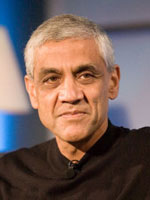 Back to back speeches by American Petroleum Institute CEO Red Cavaney and venture capitalist Vinod Khosla provided a stark contrast in ideas at the Advancing Renewable Energy Conference last week in St. Louis.
Back to back speeches by American Petroleum Institute CEO Red Cavaney and venture capitalist Vinod Khosla provided a stark contrast in ideas at the Advancing Renewable Energy Conference last week in St. Louis.
Cavaney discounted claims that the oil industry is “opposed to ethanol and is doing all it can to discourage its use. Nothing could be further from the truth,” he said. However, he noted that they are “concerned that some ethanol proponents are focused exclusively on E-85 fuel. While the industry does not object to E-85 in a free market, so long as it meets standardized technical specifications and is of reliable quality, a national emphasis on increasing ethanol volumes through E-85 can prove unnecessarily expensive and risky. If we are to encourage more long-term use of ethanol, we need to avoid surprising consumers with unanticipated problems.”
Cavaney noted the lack of cars on the road that can use e85, the decreased fuel efficiency, and the expense of installing e85 pumps as reasons why the ethanol industry should be promoting more e10 than e85. “It seems obvious that ethanol is a better value for most consumers as a gasoline additive than as E-85. As long as ethanol can be added to gasoline up to its legal limit of 10 percent by volume as a gasoline additive, it enhances octane, reduces toxics and is a viable approach. This approach creates market pressures preventing ethanol prices from falling below those of gasoline until its possible use as an additive is exhausted. And, with a 140 billion gallon national gasoline pool currently, there is considerable growth opportunity for ethanol.”
Listen to a segment of Cavaney’s remarks:  Cavaney (5 min MP3)
Cavaney (5 min MP3)
(read Cavaney’s full speech)
Coming to the podium after Cavaney, Khosla totally disagreed. “That’s the additive market, that’s what the oil companies would like us to stick with. Just be a blend into gasoline, that’s a 15 billion gallon market at e10,” he said. “I suggest that the real market is much, much larger if we let an e85 future happen.”
Khosla outlined a three mandates to make that “e85 future happen.”
1. Mandate that 70 percent of all new cars made in America be flex-fuel cars to “ensure that the consumer can pick the cheapest fuel that is available.”
2. Mandate that at least ten percent of all U.S. gas stations, either “owned or branded by any of the major suppliers” offer e85.
3. Make the current 51 cent blender’s credit a variable credit to insure against drastic ups or downs in oil prices. “I’m recommending a 25 cent credit at $75 oil and a 75 cent credit for $25 oil.”
Listen to a segment of Khosla’s remarks:  Khosla (6 min MP3)
Khosla (6 min MP3)

